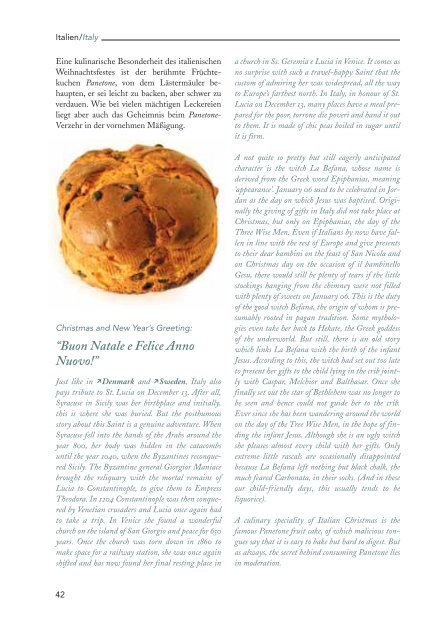Europäische Weihnacht – in Vielfalt geeint - Sutter GmbH & Co. KG
Europäische Weihnacht – in Vielfalt geeint - Sutter GmbH & Co. KG
Europäische Weihnacht – in Vielfalt geeint - Sutter GmbH & Co. KG
Sie wollen auch ein ePaper? Erhöhen Sie die Reichweite Ihrer Titel.
YUMPU macht aus Druck-PDFs automatisch weboptimierte ePaper, die Google liebt.
Italien/Italy<br />
E<strong>in</strong>e kul<strong>in</strong>arische Besonderheit des italienischen<br />
<strong>Weihnacht</strong>sfestes ist der berühmte Früchtekuchen<br />
Panetone, von dem Lästermäuler behaupten,<br />
er sei leicht zu backen, aber schwer zu<br />
verdauen. Wie bei vielen mächtigen Leckereien<br />
liegt aber auch das Geheimnis beim Panetone-<br />
Verzehr <strong>in</strong> der vornehmen Mäßigung.<br />
Christmas and New Year’s Greet<strong>in</strong>g:<br />
“Buon Natale e Felice Anno<br />
Nuovo!”<br />
Just like <strong>in</strong> jDenmark and jSweden, Italy also<br />
pays tribute to St. Lucia on December 13. After all,<br />
Syracuse <strong>in</strong> Sicily was her birthplace and <strong>in</strong>itially,<br />
this is where she was buried. But the posthumous<br />
story about this Sa<strong>in</strong>t is a genu<strong>in</strong>e adventure. When<br />
Syracuse fell <strong>in</strong>to the hands of the Arabs around the<br />
year 800, her body was hidden <strong>in</strong> the catacombs<br />
until the year 1040, when the Byzant<strong>in</strong>es reconquered<br />
Sicily. The Byzant<strong>in</strong>e general Giorgior Maniace<br />
brought the reliquary with the mortal rema<strong>in</strong>s of<br />
Lucia to <strong>Co</strong>nstant<strong>in</strong>ople, to give them to Empress<br />
Theodora. In 1204 <strong>Co</strong>nstant<strong>in</strong>ople was then conquered<br />
by Venetian crusaders and Lucia once aga<strong>in</strong> had<br />
to take a trip. In Venice she found a wonderful<br />
church on the island of San Giorgio and peace for 650<br />
years. Once the church was torn down <strong>in</strong> 1860 to<br />
make space for a railway station, she was once aga<strong>in</strong><br />
shifted and has now found her f<strong>in</strong>al rest<strong>in</strong>g place <strong>in</strong><br />
42<br />
a church <strong>in</strong> Ss. Geremia e Lucia <strong>in</strong> Venice. It comes as<br />
no surprise with such a travel-happy Sa<strong>in</strong>t that the<br />
custom of admir<strong>in</strong>g her was widespread, all the way<br />
to Europe’s farthest north. In Italy, <strong>in</strong> honour of St.<br />
Lucia on December 13, many places have a meal prepared<br />
for the poor, torrone die poveri and hand it out<br />
to them. It is made of chic peas boiled <strong>in</strong> sugar until<br />
it is firm.<br />
A not quite so pretty but still eagerly anticipated<br />
character is the witch La Befana, whose name is<br />
derived from the Greek word Epiphanias, mean<strong>in</strong>g<br />
‘appearance’. January 06 used to be celebrated <strong>in</strong> Jordan<br />
as the day on which Jesus was baptised. Orig<strong>in</strong>ally<br />
the giv<strong>in</strong>g of gifts <strong>in</strong> Italy did not take place at<br />
Christmas, but only on Epiphanias, the day of the<br />
Three Wise Men. Even if Italians by now have fallen<br />
<strong>in</strong> l<strong>in</strong>e with the rest of Europe and give presents<br />
to their dear bamb<strong>in</strong>i on the feast of San Nicola and<br />
on Christmas day on the occasion of il bamb<strong>in</strong>ello<br />
Gesu, there would still be plenty of tears if the little<br />
stock<strong>in</strong>gs hang<strong>in</strong>g from the chimney were not filled<br />
with plenty of sweets on January 06. This is the duty<br />
of the good witch Befana, the orig<strong>in</strong> of whom is presumably<br />
rooted <strong>in</strong> pagan tradition. Some mythologies<br />
even take her back to Hekate, the Greek goddess<br />
of the underworld. But still, there is an old story<br />
which l<strong>in</strong>ks La Befana with the birth of the <strong>in</strong>fant<br />
Jesus. Accord<strong>in</strong>g to this, the witch had set out too late<br />
to present her gifts to the child ly<strong>in</strong>g <strong>in</strong> the crib jo<strong>in</strong>tly<br />
with Caspar, Melchior and Balthasar. Once she<br />
f<strong>in</strong>ally set out the star of Bethlehem was no longer to<br />
be seen and hence could not guide her to the crib.<br />
Ever s<strong>in</strong>ce she has been wander<strong>in</strong>g around the world<br />
on the day of the Tree Wise Men, <strong>in</strong> the hope of f<strong>in</strong>d<strong>in</strong>g<br />
the <strong>in</strong>fant Jesus. Although she is an ugly witch<br />
she pleases almost every child with her gifts. Only<br />
extreme little rascals are occasionally disappo<strong>in</strong>ted<br />
because La Befana left noth<strong>in</strong>g but black chalk, the<br />
much feared Carbonata, <strong>in</strong> their socks. (And <strong>in</strong> these<br />
our child-friendly days, this usually tends to be<br />
liquorice).<br />
A cul<strong>in</strong>ary speciality of Italian Christmas is the<br />
famous Panetone fruit cake, of which malicious tongues<br />
say that it is easy to bake but hard to digest. But<br />
as always, the secret beh<strong>in</strong>d consum<strong>in</strong>g Panetone lies<br />
<strong>in</strong> moderation.



